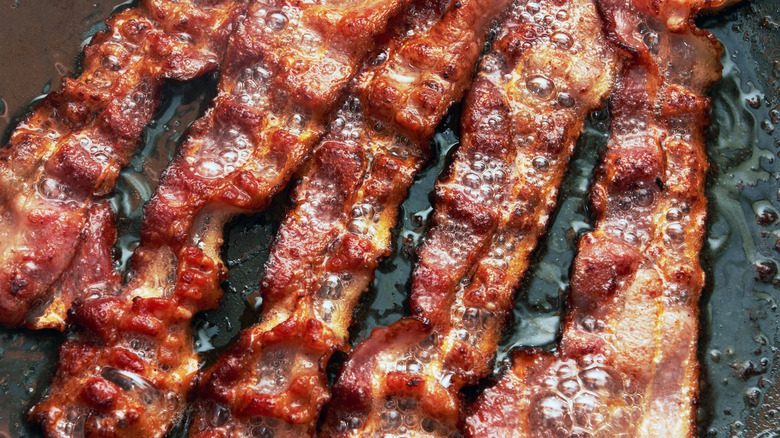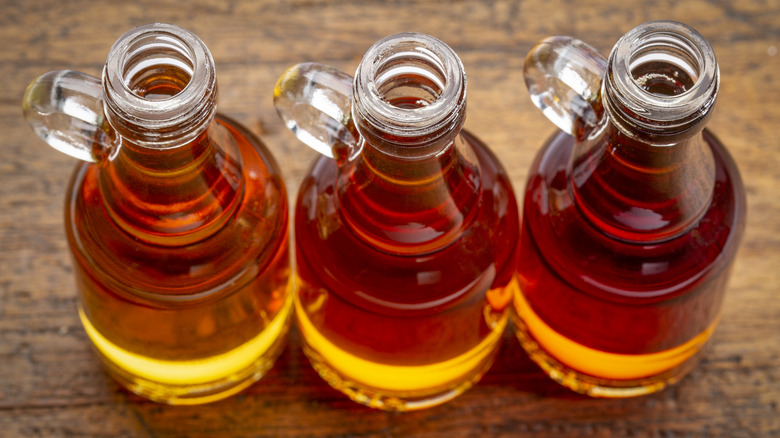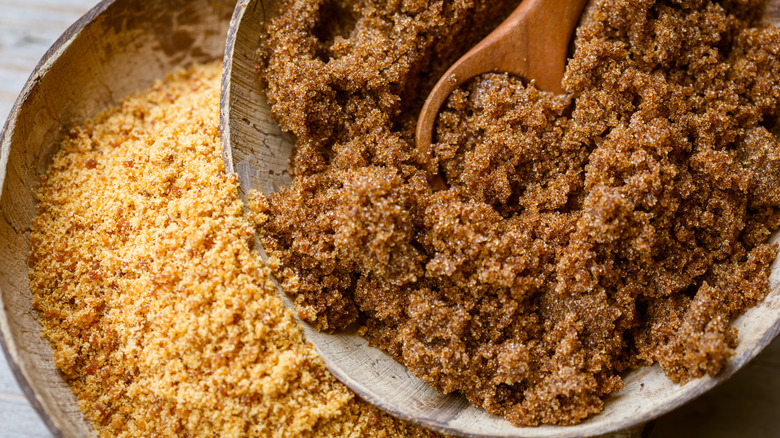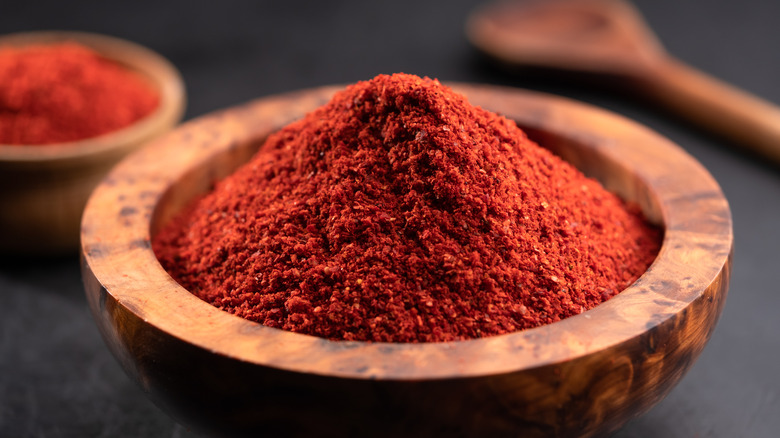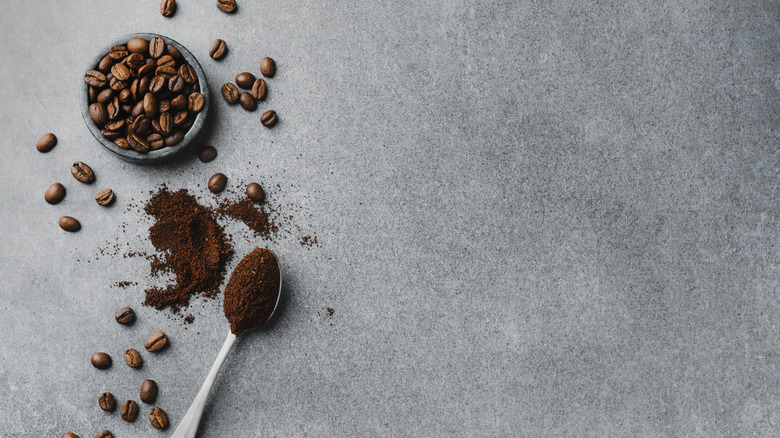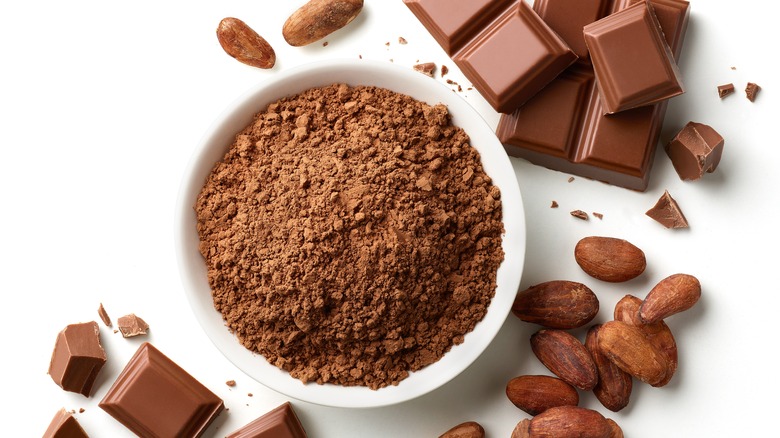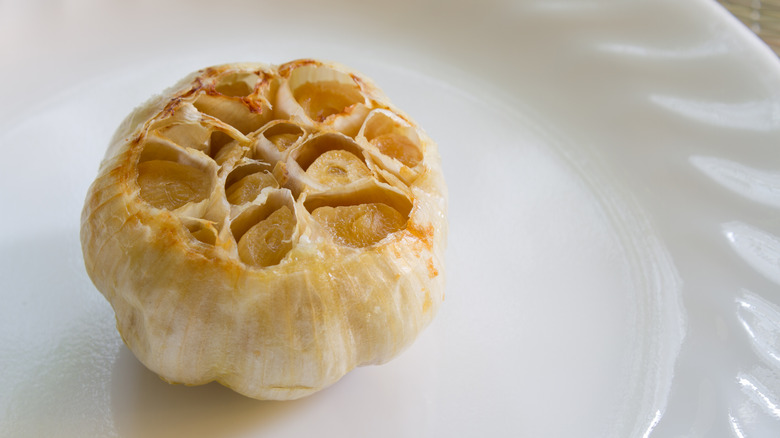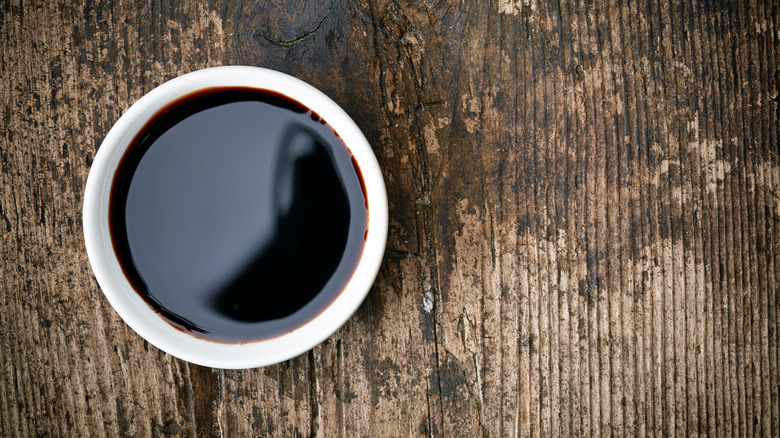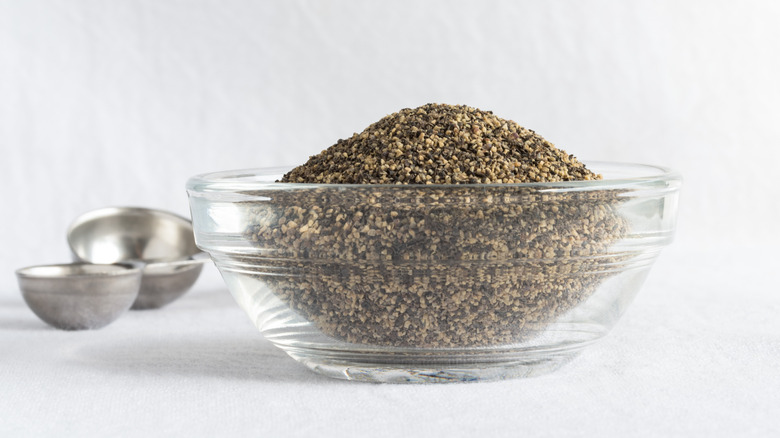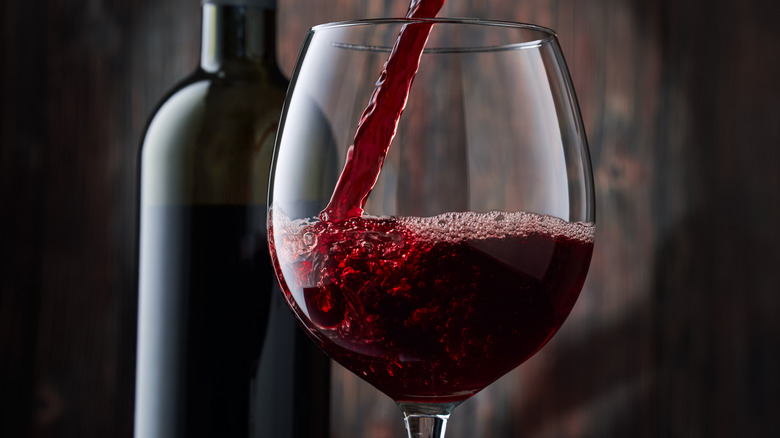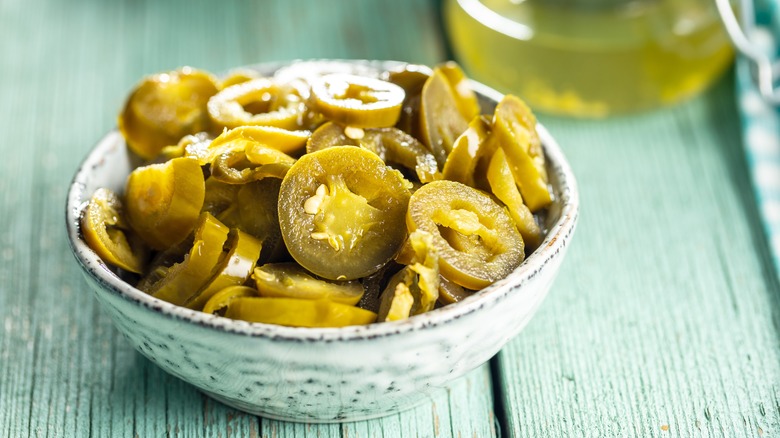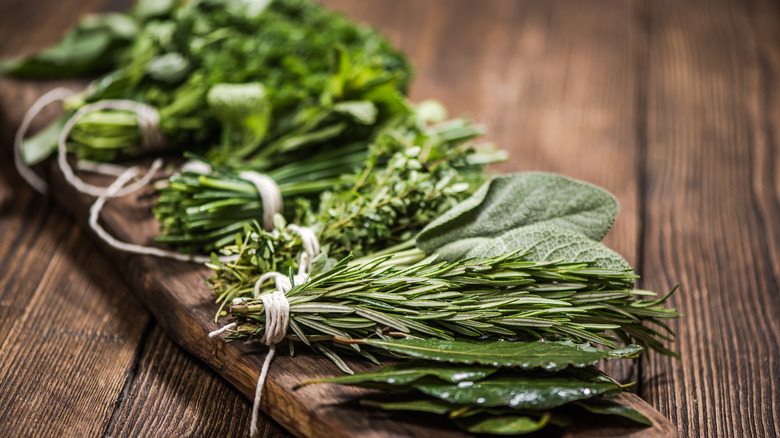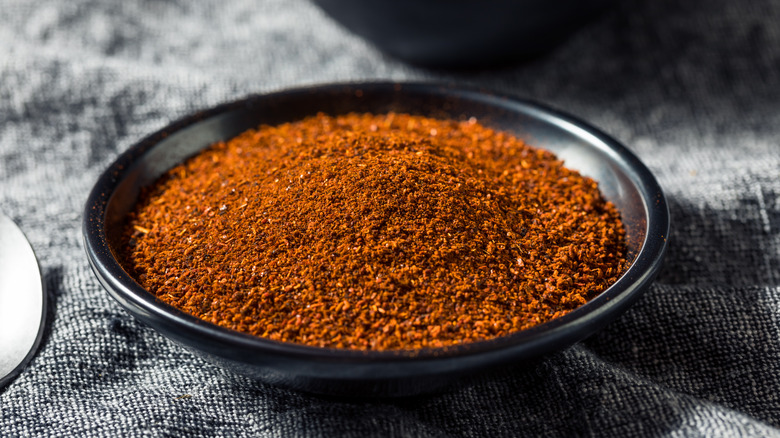13 Delicious Ways To Upgrade Your Bacon
Is there anything that isn't made better by adding bacon to it? But what about adding things to your bacon? There are many ways to season your bacon and make this delicious treat even more impressive.
Consider all the different ways you could add flavors to this breakfast food. You could make it sweeter or spicier using herbs or sugar. Or consider an option that contributes multiple flavors to your bacon, like red wine or coffee.
You can season bacon or cure it to bring out a particular flavor profile. You could even do both if you're so inclined. For example, pair a maple bacon cure with a coffee seasoning. Or mix coffee and chili powder.
Bacon is already incredibly tasty, but there are many ways to make it even more delicious. Give some popular bacon combos and recipes a try, and you'll wonder why you weren't always using these ingredients with your bacon.
1. Maple syrup
The bacon and maple syrup combo is pretty easy to understand: It works for the same reason that salted caramel does. Sweet and savory flavors pair perfectly. And maple complements the umami flavor of bacon perfectly.
Since these are both primarily breakfast foods, combining the two makes sense. And Men's Journal points out that you can layer in other flavors when you add a maple glaze to your bacon. Consider options like espresso, brown sugar, or bourbon.
This masterpiece is easy to create. Cook your bacon in a 400-degree oven for 15 to 20 minutes, then brush each strip with maple syrup before returning it to the oven for another 3 to 5 minutes.
Want even more maple flavor? Smoke your bacon in a stovetop smoker or turn your oven into one and fill it with maple wood chips. Maple-smoked bacon starts with pork belly slabs that you brine for five days before smoking.
Once you've smoked your pork belly, put it in the freezer to make it easier to slice. You can cook your bacon slices in a skillet or the oven. And if you really like maple, you can also add a maple syrup glaze.
2. Brown sugar
Try brown sugar if you're looking for an option that's even less work than maple-glazed bacon. The sugar cooks at the same time as your bacon and creates a glaze while it's in the oven. All you'll need to do is line a baking sheet with foil and add a cooling rack.
Put your bacon on the rack and coat it with brown sugar. You'll need a one-third cup of brown sugar per pound of bacon. Then pop it in a 400-degree oven for 15 to 18 minutes.
You can use this suggestion alone or partner it with other seasoning ingredients, like maple syrup or cayenne pepper. Or consider black pepper or chili powder for something with a kick.
To make this even more unique, create a balsamic brown sugar bacon glaze by combining brown sugar and balsamic vinegar. Like the maple version, you'll need to cook your bacon partially for this glaze first. Then coat it with a mixture of one-fourth cup of brown sugar and two tablespoons of balsamic vinegar for each half pound of bacon. This will give you a sweet and smoky flavor.
3. Chipotle, cayenne pepper, or chili powder
If you want to give your bacon some spice, you can use many different types of chili powders, as each contributes a different flavor. Why are they so diverse? Because, according to Greengos Cantina, they are made from entirely different ingredients.
In fact, ground chipotle (which is having a bit of a moment right now) is made from ground, smoked, and dried jalapeños. Chilli powder, on the other hand, is a blend made not just of chili peppers but also of garlic powder, cumin, and oregano. It provides a more robust flavor, but ground chipotle is smoky and just a little bit sweet.
But what about the differences in flavor profiles between cayenne and chipotle powder? First, cayenne is a much hotter spice. Cayenne rates 30,000-50,000 heat units on the Scoville Scale, while chipotle powder rates only 2,500-8,000 heat units (via Pepper Scale). But there are differences in terms of taste, too.
Cayenne has a spicy, peppery taste. But chipotle has a smoky flavor that works well in barbecues, chilis, or grilled meats: That makes it an excellent option for seasoning your next batch of bacon. Which one you ultimately choose depends on your palette. All of these peppers will complement your bacon beautifully. Which one most appeals to you?
4. Coffee
Like pepper powders, coffee helps bring out the smoky, dusky flavors of meats and other items. That's why it's used in many meat rubs and barbecue sauces. In fact, according to The Journal of Sensory Studies, the caffeine in coffee has a bitterness that can't be replicated by anything else. Testers tried other items similar in bitterness, like quinine, In trials aimed at recreating the effect, but the results were disappointing.
And like maple syrup, there's something that just works when you combine two breakfast ingredients into one bigger and better singular creation. There's a reason so many steak rubs include ground coffee. In fact, adding coffee to your bacon creates a wonderfully nutty, earthy, smoky flavor.
But bacon isn't the only thing that can benefit from the addition of coffee. It also works well in muffins, steaks, barbecue sauces, and many other items you might want to boost with bolder, more flavorful effects.
5. Cocoa or chocolate
You may have heard that chocolate works wonders in chili, but did you know that it can also be used to create a delicious piece of bacon? Like other sweet and savory combinations, the two different flavor profiles offset each other. And like coffee and chipotle, you get a smoky element as well. This one ingredient works double-duty.
The Washington Post points out that earlier generations of humankind regularly used chocolate in savory cooking. Many considered the cacao bean a sacred gift of the gods, and cooking with it would have been considered sacrilege. But it was also used in many dishes and sauces.
The crushed cacao bean works much like other seeds used in cooking, such as coriander, cumin, fennel, and black pepper. When cocoa is dusted on bacon, it can add a whole new element to your breakfast meat.
If you're thinking about the candy bars that you traditionally associate with chocolate, stop. Those are not what you want to use on your bacon, though many candy bars have begun adding salty breakfast meat to their sugary bars for contrast.
You want to use natural cacao for bacon, the type you're likely to find in dark chocolate bars that have a 70% cocoa content or higher. Or better yet, use the beans themselves. They have a subtle, fruity flavor that works best when you grind your beans fresh immediately before using them.
6. Roasted garlic
Roasted garlic lends a milder flavor to bacon. It would still work well with your bacon at full flavor, but roasting it first helps it blend with the taste of the meat better. You can buy roasted garlic powder and dust your bacon with it or roast the garlic yourself and add it to the skillet you're cooking your bacon in. The final result will be a nutty taste.
We've already discussed how that profile pairs beautifully with bacon, but how do you roast garlic if you want to make it yourself? There are a couple of ways. The easiest, most common method is to wrap the garlic in foil and roast it in the oven at 400 degrees for 30 minutes: This is easy to prepare and clean up.
Don't want to use foil? Try two muffin tins instead. Place the bulb in one of your muffin tins and cover it with the other. Then cook the same way you would your foil-wrapped garlic. You can also roast them in an air fryer or a slow cooker. Or, if you only have cloves on hand, submerge them in oil in a casserole dish and bake them in the oven for 30 minutes at 400 degrees or roast them in oil in a skillet for 20 minutes.
7. Balsamic vinegar
This one should come as no surprise to anyone who eats brussels sprouts. Bacon and balsamic are often accompanied by little green vegetables, and it's easy to understand why. Balsamic is sweet and a bit savory all on its own, making it an ideal match for bacon.
When cooking up your next batch of bacon, consider the flavors in a balsamic-roasted Brussels sprouts recipe: It uses balsamic vinegar, maple syrup, olive oil, and grainy mustard. These flavors would work nicely with your bacon and offset one another in a way few other flavor combinations could.
Want something a little less complicated? According to Today, Guy Fieri likes his Brussels sprouts with pancetta (Italy's version of bacon), balsamic vinegar, pine nuts, raisins, currants, salt, pepper, and capers. The easiest way to use balsamic on your bacon is as a glaze.
Food Network personality Bobby Flay suggests brushing your partially baked bacon with a balsamic glaze before popping it back in the oven. Want it even sweeter? Try adding brown sugar. Flay explains that sweet glazes can make all the difference in your bacon and recommends using pomegranate molasses.
8. Black pepper
McCormick explains that peppercorns were once so rare that they were included in dowries. Fortunately, they're much easier to come by today, and they make a delicious addition to your bacon. Peppercorns have a long shelf life, and they help accentuate the flavor of your existing foods without overpowering them.
Even better, pepper pairs delightfully with many other flavors that accentuate your bacon. Spices like thyme, garlic, paprika, and rosemary work well with pepper and bacon: Pepper helps to emphasize some of these other flavors as well.
Pepper is a perfect counterbalance to sweet flavors. If you're going this route, try making your own bacon. Buy or order pork belly, and treat it to a dry rub of pepper, brown sugar, garlic, onion, thyme, pink salt, and bay. It will need to cure for seven to ten days, but you should flip it after three to four.
If you want to smoke the bacon after it cures, you'll need to let it sit one extra day. Or cook it in the oven: This is the initial cooking phase. You will still need to fry or bake it in the oven later. For a truly unique experience, try cold smoking your freshly cured bacon.
9. Red wine
Need proof that red wine pairs well with bacon? Look no further than coq au vin. The recipe calls for red wine and bacon, and the quintessentially French meal is now the height of haute cuisine. This is a bit ironic because it had humble beginnings as peasant food.
The great news is that you can get those same flavors in your bacon. Create a glaze for your bacon using red wine, Dijon mustard, and brown sugar. Like other glaze recipes, you'll want to par-bake your bacon before applying this. Putting a glaze on too early will cause it to burn, particularly this one, since it contains both sugar and alcohol. Once they're out of the oven, let them cool before serving.
And if you're looking for something really extravagant, you can even use red wine to create candied bacon. Candied bacon calls for intense, full-bodied, sweet flavors, so you'll want to use port for this recipe as well as brown sugar. Brush your bacon with the port, sprinkle with brown sugar on both sides, and pop it in the oven. Cook at 400 degrees for 30-40 minutes or until the brown sugar has caramelized.
10. Bourbon
If you're looking for a different kind of alcohol to flavor your bacon with, consider bourbon. It is smoky and sweet, with hints of vanilla, and can give your bacon a little kick. It will also help enhance your bacon's natural flavor.
But first, what is bourbon? According to Alcohol Professor, it's a type of whiskey, but there are six necessary characteristics required to categorize a whiskey as bourbon. First, it must be made in the U.S., though not necessarily in Kentucky. It must be predominantly corn, 51% or higher.
It must also be distilled at less than 160 proof and enter the barrel at less than 125 proof. It must be barreled in charred white oak and cannot contain artificial coloring or flavors. Out of the bottle, it shouldn't have anything added to it, either, other than water.
How does it help in your cooking, and your bacon specifically? There are two ways. First, as the alcohol evaporates, it elevates fragrance molecules from your food. And so much of what we can taste comes from what we can smell. Second, the alcohol bonds with fats and water, which aids in delivering taste molecules. It's the same reason that using alcohol to deglaze a pan creates a tastier sauce than using broth or water.
11. Jalapeños
Like balsamic vinegar, this one is practically a no-brainer. You've probably had bacon-wrapped jalapeño popper appetizers before. But did you know you can also create a version of this flavor in your bacon and save all the time you would have spent putting together an appetizer? Better yet, no one will look at you funny for eating this version for breakfast.
Start with a baking sheet wrapped in foil and set a cooling rack on top of it. This will be your baking surface. Melt bacon fat or butter in a skillet and sauté chopped jalapeños. Add brown sugar, pepper, salt, and water and heat until the sugar melts. Allow to cool and pulse in a blender or food processor. You want to blend your flavors and make the mixture a bit less chunky, but it doesn't need to be completely smooth.
Pour your sauce into a shallow dish and dredge your bacon to coat, then arrange it on your baking rack and put it in the oven for 30-35 minutes. Let it cool, and then sprinkle some additional chopped jalapeño on top. The result will perfectly complement your next Bloody Mary.
12. Rosemary and thyme
Rosemary and thyme are delightful flavors and pair exceptionally well with pork. Foodprint points out the "twiggy" herbs are favorite fall flavors. Thyme works well in creole and Cajun dishes, and as we've already discussed, spicy flavors are a big hit when paired with bacon. Consider adding some thyme along with your spicy flavor, or mix it with rosemary, a fellow woody herb.
Rosemary cooperates well with fatty meats, making it an excellent choice for bacon. It has a more assertive flavor profile than thyme, so you should chop it before using it in your recipes. It also works well with salt, garlic, or lemon zest, which also pair delightfully with your bacon. The herb was featured in wedding ceremonies in England in the 11th Century.
If you live in a temperate climate, you can possibly grow thyme and rosemary year-round. These plants flourish from late spring to late fall in colder climates, giving you ample time to use them in your bacon preparation.
13. Smoked paprika
You may have guessed that smoked paprika has a smoky flavor. Some people even compare it to the flavor of bacon. In fact, several "fake bacon" recipes use smoked paprika to mimic the taste of the real thing. Add it to your real bacon to give it a deeper, richer flavor and a gorgeous shade of red.
According to America's Restaurant, smoked paprika is made from peppers roasted slowly over oak and ground into powder. Paprika will give a gorgeous deep red color to your foods, but it may not add much flavor, depending on the type of peppers used. It can be made from cayenne, red pepper, chipotle, poblano, or bell peppers.
Smoked paprika has a smoky, earthy flavor that will make your bacon more complex. It can reach as high as 33,000 heat units on the Scoville scale, but it's not known for being a hot spice. It is similar in flavor to traditional paprika, though smokier and less sweet.
